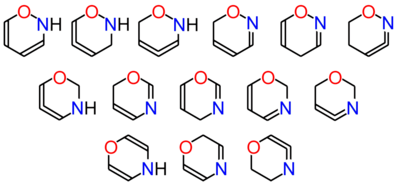- Oxazines
-
Oxazines are heterocyclic compounds containing one oxygen and one nitrogen.
Many isomers exist depending on the relative position of the heteroatoms and relative position of the double bonds
By extension, the derivatives are also referred to as oxazines; examples include ifosfamide and morpholine (tetrahydro-1,4-oxazine). A commercially available dihydro-1,3-oxazine is a reagent in the Meyers synthesis for aldehydes. Fluorescent dyes such as Nile red and Nile blue are based on the aromatic benzophenoxazine.
Benzoxazine is a molecule where an oxazine ring a heterocyclic six-membered ring with oxygen and nitrogen atom which is attached to a benzene ring. There are several benzoxazine structures depending on the position of the heteroatoms. The numbering is made in such a way that the oxygen position precedes the nitrogen. Thus, structure c is a 1,4-benzoxazine. This is because the benzoxazine was originally the compound with a double bond, such as in structured. The word, dihydro, indicates the hydrogenated version of benzoxazine. It is the 1,3-benzoxazines that are the subject of interest for development of polymeric materials as this class of benzoxazines readily polymerizes via cationic ring-opening polymerization. The IUPAC name avoids the reversing of 1,3 into 3,1 from the structure a into. Instead, the position of the oxygen is indicated by [e] for structure and [d] for structure b by alphabetically counting the atoms in the oxazine ring. While the accurate naming must still follow IUPAC notation, it is very complex and impractical for routine use. Thus, a convention has been developed to abbreviate the name of the benzoxazine.
See also
- phenoxazine
- Category:Oxazaphosphinans
Images
External links
Categories:
Wikimedia Foundation. 2010.



